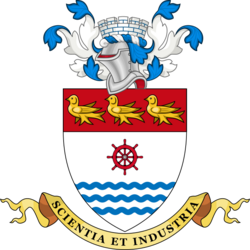National University of Nakong: Difference between revisions
mNo edit summary |
No edit summary |
||
| Line 5: | Line 5: | ||
| image = Arms of the National University of Nakong.png | | image = Arms of the National University of Nakong.png | ||
| image_size = 250px | | image_size = 250px | ||
| caption = Coat of arms | | caption = [[#Coat of arms|Coat of arms]] | ||
| former_name = Nakong Normal and Medical College (1936–1939)<br />University College of Nakong (1939–1952) | | former_name = Nakong Normal and Medical College (1936–1939)<br />University College of Nakong (1939–1952) | ||
| motto = ''Scientia et industria'' ({{wp|Latin|Solarian}}) | | motto = ''Scientia et industria'' ({{wp|Latin|Solarian}}) | ||
| Line 53: | Line 53: | ||
== Coat of arms == | == Coat of arms == | ||
The {{wp|heraldic achievement}} of the National University of Nakong comprises a blue {{wp|helmet (heraldry)|helmet}}, the motto "Scientia et industria" ({{wp|Latin|Solarian}} for "Science and industry"), and a shield reminiscent of the [[coat of arms of Nakong]]. The shield features an escutcheon replicating the national symbol of the red wheel over blue waves and overlays a {{wp|chief (heraldry)|chief}} which features three gold {{wp|martlet|martlets}}. As feetless birds who cannot land, martlets are a traditional symbol of the unending pursuit of knowledge at schools and universities. The motto was selected to honour the past and future of the university, with science representing the institution's evolution into a {{wp|research university}} and industry representing its origins as a {{wp|professional school}} for the training of teachers and physicians. | |||
The shield and motto were granted by the [[Estmere|Estmerish heraldic authority]] to the University College of Nakong in 1940. The arms were later {{wp|Augmentation of honour|augmented}} with the addition of the helmet by the [[Nakong Free State Legislative Assembly]] in 1952 when the institution became a full university. | |||
== Campus == | == Campus == | ||
Revision as of 11:29, 31 December 2023
內江國立大學 | |
 | |
Former name | Nakong Normal and Medical College (1936–1939) University College of Nakong (1939–1952) |
|---|---|
| Motto | Scientia et industria (Solarian) |
Motto in English | Science and industry |
| Type | Public research university |
| Established | 29 April 1936 (as specialized college) 3 August 1939 (as university college) |
Academic affiliation | Nakong Federation of Universities Nakong Research Group COMDEV Universities |
| Endowment | $1.01 billion |
| Chancellor | David Chang Ka-chun |
| President | James Lee Yat-tak |
| Vice-Chancellor | James Lee Yat-tak |
| Provost | R. Michael Milton |
| Visitor | Diane Lau Yuet-kwong (as President of Nakong) |
Academic staff | 2,466 |
| Students | 33,690 |
| Undergraduates | 25,451 |
| Postgraduates | 8,239 |
| Location | , |
| Campus | Urban, 117 ha (289 acres) |
| Language | Nakongese and Estmerish |
| Colours | Red and blue |
| Website | www.nun.nk |
 | |
| National University of Nakong | |||||||||||||
|---|---|---|---|---|---|---|---|---|---|---|---|---|---|
| Simplified script | 内江国立大学 | ||||||||||||
| Traditional script | 內江國立大學 | ||||||||||||
| |||||||||||||
The National University of Nakong (NUN; Shangean: 內江國立大學; Morwall romanization: noi6 gong1 gwok3 lap6 daai6 hok6) is a public research university in Ningcho, Nakong. As the oldest and consistently highest-ranked university in Nakong, it is widely regarded as the nation's premier national university.
The National University of Nakong was first formed by private benefactors in 1936 as the Nakong Normal and Medical College, the first medical and normal school in the Colony of Nakong, in order to combat a chronic shortage of doctors and teachers on the island. In 1939, the school received a charter from the Parliament of Estmere in 1939 to become the University College of Nakong, a post-secondary institution focused on undergraduate education and vocational skills. Under the Nakong Free State, the college was transformed in 1952 into a full-fledged research university and adopted the name of the National University of Nakong. Along with the private Sotirian Farnley University, NUN is one of two schools to attain the status of university prior to the independence of Nakong.
Today, the National University of Nakong boasts 2,466 faculty members and 33,690 enrolled students across 16 schools and faculties, in addition to professional development and continuing studies programs. Notable alumni include Prime Minister Andrew Ng, former prime minister James Lee (who now serves as Vice-Chancellor of his alma mater), and Foirbeis Award physics laureate George Cheung Chu-ming. NUN is part of the Nakong Research Group association of major Nakongese research universities.
Graduates of the National University of Nakong form a university constituency in the House of Deputies of Nakong. The incumbent Member of Parliament for the NUN is Barbara Tam Chiu-fun of the Self-Determination Congress.
History
Early history
Present form
Coat of arms
The heraldic achievement of the National University of Nakong comprises a blue helmet, the motto "Scientia et industria" (Solarian for "Science and industry"), and a shield reminiscent of the coat of arms of Nakong. The shield features an escutcheon replicating the national symbol of the red wheel over blue waves and overlays a chief which features three gold martlets. As feetless birds who cannot land, martlets are a traditional symbol of the unending pursuit of knowledge at schools and universities. The motto was selected to honour the past and future of the university, with science representing the institution's evolution into a research university and industry representing its origins as a professional school for the training of teachers and physicians.
The shield and motto were granted by the Estmerish heraldic authority to the University College of Nakong in 1940. The arms were later augmented with the addition of the helmet by the Nakong Free State Legislative Assembly in 1952 when the institution became a full university.